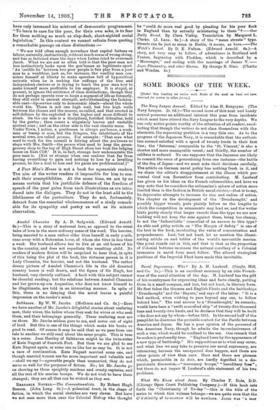SOME BOOKS OF THE WEEK.
[Under this heading we notice such Books of the week as haw not boon reserved for review in other forms.] The Navy League Annual. Edited by Alan H. Burgoyne. (The Navy League. 2s. 6d.)—The second issue of this neat and handy annual possesses an additional interest this year from incidents which must have stirred the Navy League to the very depths. We can only notice points worthy of the attention of all readers, recol- lecting that though the writers do not class themselves with the alarmists, the separating partition is a very thin one. As to the progress of the Japanese Navy, it is remarkable that the authori- ties seemed satisfied with a speed of twenty knots in their first line ; the Satsuma,' comparable to the Bt. Vincent,' is also a shorter and more manageable vessel ; and thirdly, the number of calibres is reduced. No one supposes that the Japanese are likely to commit the error of generalising from one instance—the battle of the Sea of Japan—and we must note their decisions carefully. The article on German naval policy has nothing fresh in it, and we share the editor's disappointment at the illness which pre- vented Graf von Reventlow from contributing. M. Laubeuf has given us his ideas on the French submersibles, and here we may note that he considers the submarine's sphere of action more limited than is the fashion in British naval circles,—that is to say, he deprecates attempts to increase its size and radius of action. The chapter on the development of the 'Dreadnought,' and possibly bigger vessels, puts plainly before us the lengths to which the competition in armaments may lead us, and the writer hints pretty clearly that larger vessels than the type we are now building will not keep the seas against them, being too clumsy. Is not the `Indomitable' somewhat of an answer to this type? An able and pithy article on " The Margin of Safety " is one of the best in the book, inculcating the value of concentration and preponderance. Last, but not least, let us mention the illumi- nating article on and tables of the world's mercantile marine. One point stands out in this, and that is that as the proportion of Colonial bottoms increases the natural corollary of a Colonial insurance in naval form must follow. The altered strategical positions of the Imperial Fleet have made this inevitable.










































 Previous page
Previous page